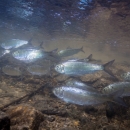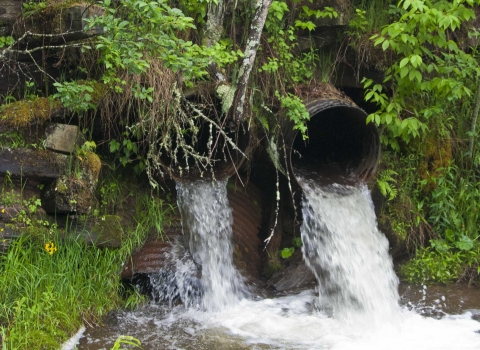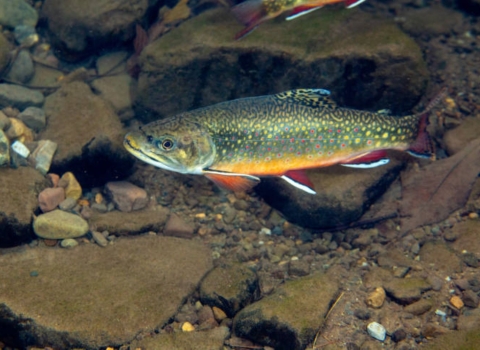What We Do
The Appalachian Fish and Wildlife Conservation Office restores and protects important fish and wildlife habitats on private lands through partnerships. We help assess, plan, and conduct habitat restoration, including removing dams and replacing road-stream crossings and culverts with structures that are resilient to high water flows and allow better fish passage fish passage
Fish passage is the ability of fish or other aquatic species to move freely throughout their life to find food, reproduce, and complete their natural migration cycles. Millions of barriers to fish passage across the country are fragmenting habitat and leading to species declines. The U.S. Fish and Wildlife Service's National Fish Passage Program is working to reconnect watersheds to benefit both wildlife and people.
Learn more about fish passage at all times of the year.
Our office
- Restores habitat for fish and wildlife on tribal, county and municipal lands
- Provides technical assistance to private landowners on enhancing habitat for fish and wildlife on their property, including:
- Restoring wetlands, riparian riparian
Definition of riparian habitat or riparian areas.
Learn more about riparian , in-stream and upland / forested habitats - Controlling invasive species invasive species
An invasive species is any plant or animal that has spread or been introduced into a new area where they are, or could, cause harm to the environment, economy, or human, animal, or plant health. Their unwelcome presence can destroy ecosystems and cost millions of dollars.
Learn more about invasive species - Planting native trees and shrubs
- Fencing livestock out of stream and riparian areas
- Restoring wetlands, riparian riparian
- Cooperates with the U.S. Department of Agriculture on the Farm Bill Program, Wildlife Habitat Incentive Program, Environmental Quality Incentive Program, Wetlands Reserve Program and the Conservation Reserve Program.
- Works with others to remove barriers to fish passage, including replacing aging or undersized road-stream crossings with structures that are resilient to high flows
- Develops habitat restoration projects and secures funding through the the National Fish Passage Program, the National Fish Habitat Partnership, and Partners for Fish and Wildlife Program.
- Collaborates and strengthens partnerships within the Eastern Brook Trout Joint Venture (EBTJV), the Atlantic Coastal Fish Habitat Partnership, and the Ohio River Basin Fish Habitat Partnership (ORBFHP).
- Conducts outreach and education with youth and their families on the unique natural resources of the central Appalachians, such as native brook trout, crayfish, freshwater mussels, and Appalachia’s amazing network of rivers, streams and springs which are vital to fish and wildlife, and humans.
Management and Conservation
We work with private landowners and others to restore streams, wetlands, and forest and upland habitats for migratory birds and fish, pollinators, and federally listed species. We leverage funds and resources through efficient state, federal and private partnerships to accomplish shared habitat restoration goals.
Our Projects and Research
Private landowners provide long-term stewardship of the land and are a key component in all successful restoration projects. We work with landowners and other partners to restore streams, wetlands, and forest and upland habitats for migratory birds and fish, pollinators, and federally listed species. Voluntary cost-share programs offer a chance to regain some of West Virginia's most important natural resources and build on the strength and interest of committed individuals and organizations to accomplish shared conservation goals. View our Projects page to learn more about some of the programs we work through to us help restore habitat for fish and wildlife on private lands.
The Potomac Headwaters Fish Passage Restoration Project is a watershed scale project to reconnect over 195 miles of habitat for brook trout, American eel, and other aquatic species in the Potomac Headwaters of the Chesapeake Bay across the states of Maryland, Virginia, and West Virginia. The project is composed of up to 17 fish passage barrier removal projects including culvert...
The Partners for Fish and Wildlife program provides technical and financial assistance to private landowners to restore and enhance fish and wildlife habitat on their property. The program’s focus is to restore habitat to benefit federally listed and at-risk species.
Who's Eligible?Technical assistance is available to all landowners. Financial assistance can not be spent on...
West Virginia’s Potomac Headwaters Home Rivers Initiative
Partners: Trout Unlimited, USDA Farm Service Agency, U.S. Fish and Wildlife Service, National Fish and Wildlife Foundation, West Virginia Division of Natural Resources, and West Virginia Conservation Agency
Location: Upper North Fork South Branch Potomac River, West Virginia
The need: High elevations and Project...
Removing three dams on the West Fork River back in 2016 has improved boating access and fish passage along the river. But perhaps more importantly to local residents, the river's water quality and drinking water is improved, and it's safe to go boating and swimming now that the dams have been removed. Indeed, the river is becoming a tourist destination for anglers and boaters - improving...
Across the landscape, undersized, aging and improperly placed road-stream crossings create barriers in our rivers, streams, and tidal wetlands. These structures fragment aquatic habitat and prevent or greatly reduce the ability of aquatic species to move freely to migrate, feed, and reproduce. These poorly designed structures are also more prone to clogging, causing flooding, and washing out...




